
by Laura Tiu | May 13, 2022
The northwest Florida area has been identified as having the highest concentration of invasive lionfish in the world. Lionfish pose a significant threat to our native wildlife and habitat with spearfishing the primary means of control. Lionfish tournaments are one way to increase harvest of these invaders and help keep populations down. Not only that, but lionfish are a delicious tasting fish and tournaments help supply the local seafood markets with this unique offering.
Since 2019, Destin, Florida has been the site of the Emerald Coast Open (ECO), the largest lionfish tournament in the world. While the tournament was canceled in 2020, due to the pandemic, the 2021 tournament and the Lionfish Removal and Awareness Day festival returned to the Destin Harbor and led to the removal of over 10,000 invasive lionfish.
This weekend, May 14 and 15, 2022, the tournament and festival will be in back in full force at HarborWalk Village in Destin Harbor. A record number of teams will be on the water competing for cash prizes and other loot. Florida Sea Grant will be on hand to support the two-day festival that will include lionfish tasting and fillet demonstrations, conservation and art booths, interactive kids zone, shopping, and lionfish viewing! Bring your family and friends out to support this unique event and do your part to help fight invasive lionfish.
For more information on the tournament, visit EmeraldCoastOpen.com or Facebook.com/EmeraldCoastOpen.
For information about Lionfish Removal and Awareness Day, visit FWCReefRangers.com
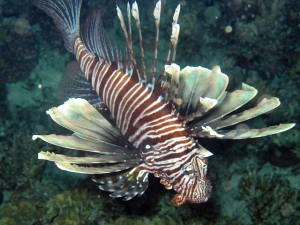
The Invasive Lionfish
“An Equal Opportunity Institution”
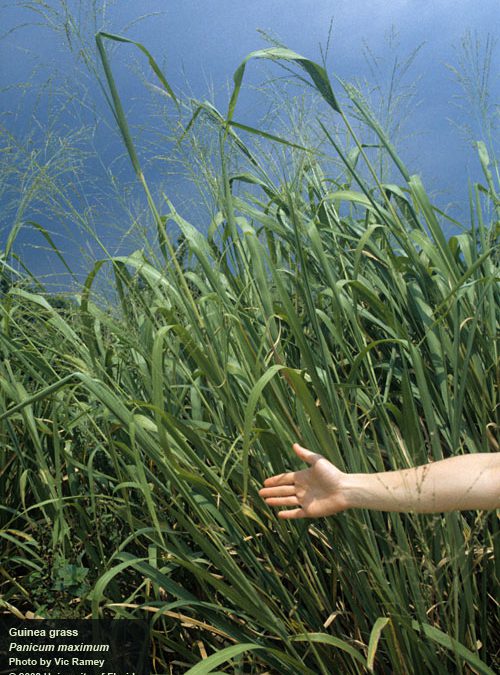
by Rick O'Connor | May 13, 2022
EDRR Invasive Species
Guinea Grass (Megathyrus maximum)

Guinea Grass
Photo: University of Florida IFAS
Define Invasive Species: must have ALL of the following –
- Is non-native to the area, in our case northwest Florida
- Introduced by humans, whether intentional or accidental
- Causing either an environmental or economic problem, possibly both
Define EDRR Species: Early Detection Rapid Response. These are species that are either –
- Not currently in the area, in our case the Six Rivers CISMA, but a potential threat
- In the area but in small numbers and could be eradicated
Native Range:
Guinea grass is native to Africa.
Introduction:
The plant was introduced as livestock fodder.
EDDMapS currently list 2,614 records of guinea grass. Most records come from Florida and Texas, but it has also been reported in Hawaii and Puerto Rico. In Florida it has been reported across the state. There are 17 records in the Florida panhandle, 15 of those within the Six Rivers CISMA, 12 of those within the CISMA were reported from the Yellow River Preserve area in Santa Rosa County and the remaining three were from Eglin AFB.
Description:
This is a large panicum grass reaching heights of up to seven feet and grows in dense mats. The strap-like blades and smooth and up to three feet long and two inches wide. The seed inflorescence is large as well, reach two feet in length.
Issues and Impacts:
Guinea grass is an aggressive growing plant that will quickly occupy disturbed open spaces and form thick monocultures decreasing native plant abundance and overall biodiversity.
Management:
The recommended management is foliar spraying with a 1% solution of glyphosate. Care should be taken not to overspray because this herbicide is non-selective and will kill other desirable plants.
Please report any sighting to www.EDDMapS.org
For more information on this EDRR species, contact your local extension office.
References
Urochola maximum. Guinea Grass. University of Florida Center for Aquatic and Invasive Species. | Center for Aquatic and Invasive Plants | University of Florida, IFAS (ufl.edu).
Sellers, B., Smith, H., Ferrell J. 2018. Identification and Control of Johnsongrass, Vaseygrass, and Guinea Grass in Pastures. University of Florida Electronic Data Information System. SS-AGR-363. pdf\AG\AG372\AG372-16272415.pdf (ufl.edu)
Early Detection and Distribution Mapping System (EDDMapS)
https://www.eddmaps.org/
Six Rivers CISMA
https://www.floridainvasives.org/sixrivers/
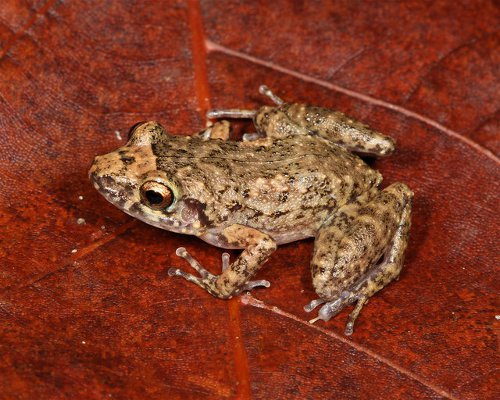
by Rick O'Connor | Apr 15, 2022
EDRR Invasive Species
Greenhouse Treefrog (Eleutherodactylus planirostris)

Greenhouse Treefrog
Photo: U.S. Geological Survey
Define Invasive Species: must have ALL of the following –
- Is non-native to the area, in our case northwest Florida
- Introduced by humans, whether intentional or accidental
- Causing either an environmental or economic problem, possibly both
Define EDRR Species: Early Detection Rapid Response. These are species that are either –
- Not currently in the area, in our case the Six Rivers CISMA, but a potential threat
- In the area but in small numbers and could be eradicated
Native Range:
Greenhouse treefrog is native to Cuba, the Cayman Islands, and the Bahamas.
Introduction:
The Greenhouse treefrog may have been accidentally introduced on shipments of tropical plants from the Caribbean. Another study suggest it may have drifted across from Cuba on debris. The earliest record is from 1863 in the Florida Keys.
EDDMapS currently list 924 records of the Greenhouse treefrog. EDDMapS records include 22 counties in Florida and 2 in Georgia. However, the USGS reports records from 49 geographic locations in Florida, 8 in Louisiana, 6 in Hawaii and Alabama, 5 in Georgia, 2 in Mississippi and 1 each in Guam, Missouri, Oklahoma, and Texas.
EDDMapS records within Six Rivers CISMA include Escambia and Okaloosa counties. The USGS records include records in Okaloosa, Santa Rosa, and Escambia counties.
Description:
This is a small frog reaching lengths of only 1.25”. Reddish brown to bronze in color with dark blotches over the body. There may be a dark triangle or chevron pattern between the red eyes. The toes are long and thin and tipped with tiny toe pads and lack webbing.
Issues and Impacts:
The impact of this non-native is still unclear. The species has been a resident in Florida for over 100 years with no noticeable impacts. It has been found co-habitating with some native species. There is some concern in Hawaii and Guam, but local impacts seem to be minimal.
Management:
With little or no negative impact, management recommendations are not provided, and maybe not be needed. If you are having a problem with this species, contact your local county extension office for advice.
References
Johnson, S.A. 2020. Florida’s Frogs and Toads. The Greenhouse Treefrog (Eleutherodactylus planirostris). Johnson Lab, University of Florida Department of Wildlife Ecology and Conservation. https://ufwildlife.ifas.ufl.edu/frogs/greenhousefrog.shtml.
The Greenhouse Treefrog (Eleutherodactylus planirostris). University of Florida Extension. https://wec.ifas.ufl.edu/extension/wildlife_info/frogstoads/eleutherodactylus_planirostris_planirostris.php.
Partymiller, L. The Greenhouse Treefrog (Eleutherodactylus planirostris). Savannah River Ecology Laboratory. University of Georgia. https://srelherp.uga.edu/anurans/elepla.htm.
Somma, L.A., 2022, Eleutherodactylus planirostris (Cope, 1862): U.S. Geological Survey, Nonindigenous Aquatic Species Database, Gainesville, FL, https://nas.er.usgs.gov/queries/FactSheet.aspx?speciesID=61, Revision Date: 5/31/2019, Access Date: 4/11/2022. https://nas.er.usgs.gov/queries/FactSheet.aspx?speciesID=61.
Early Detection and Distribution Mapping System (EDDMapS)
https://www.eddmaps.org/
Six Rivers CISMA
https://www.floridainvasives.org/sixrivers/
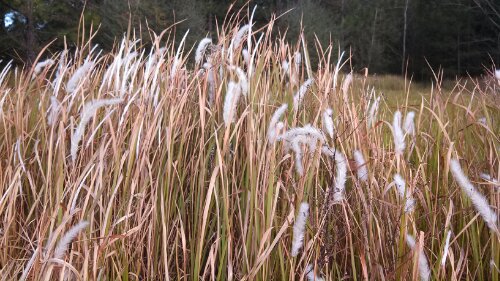
by Jennifer Bearden | Mar 18, 2022
Invasive species are defined as introduced plants and animals that cause harm to the environment, the economy, and/or human health. They often displace native species further harming the ecosystem. Many times, invasive species are introduced by humans either intentionally or unintentionally. This means WE can do some things to combat the spread of invasive species.

The Invasive Lionfish
In the case of intentional introductions, we typically see either plants or animals moved from native lands to our area. Most often, the mover does not know the species is dangerous to our area. Other times, they know the species is invasive, but they introduce them anyway. Exotic pets are one of the ways invasive species are introduced. The Burmese python is an example of this as well as the lionfish. These pets were released by owners who grew tired of caring for their unique needs. So, one thing we can do is encourage people to research exotic pets prior to owning them. Also, encourage people to take advantage of Florida Fish and Wildlife Conservation Commission’s exotic pet amnesty program. For plants, people should not bring any plant materials into Florida without going through the proper regulatory process.
Sometimes, introductions of invasive species are accidental. Invasive species can hitch a ride on clothing, animal fur, vehicles, and equipment. Cogongrass and Old World climbing fern are examples of plants that were moved around on vehicles and equipment. Also, invasive species can stow away in packing materials and find their way to Florida. Florida has an exceptional process to intercept invasive species, but we do see them slip in occasionally. Be very vigilant when shipping items either into or out of Florida. Clean equipment and vehicles when working in areas where invasive species are found.
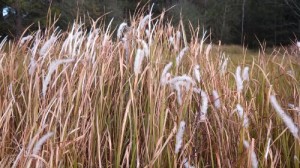
Cogongrass flowering
Florida’s climate and ports of entry allow new species to get here and survive. It is difficult and expensive to eradicate an invasive species once it becomes established. Our best defense is to do our part in stopping the spread of invasive species. For more information on invasive species, you can contact your local extension agent or go to the UF IFAS Invasive Species Program.
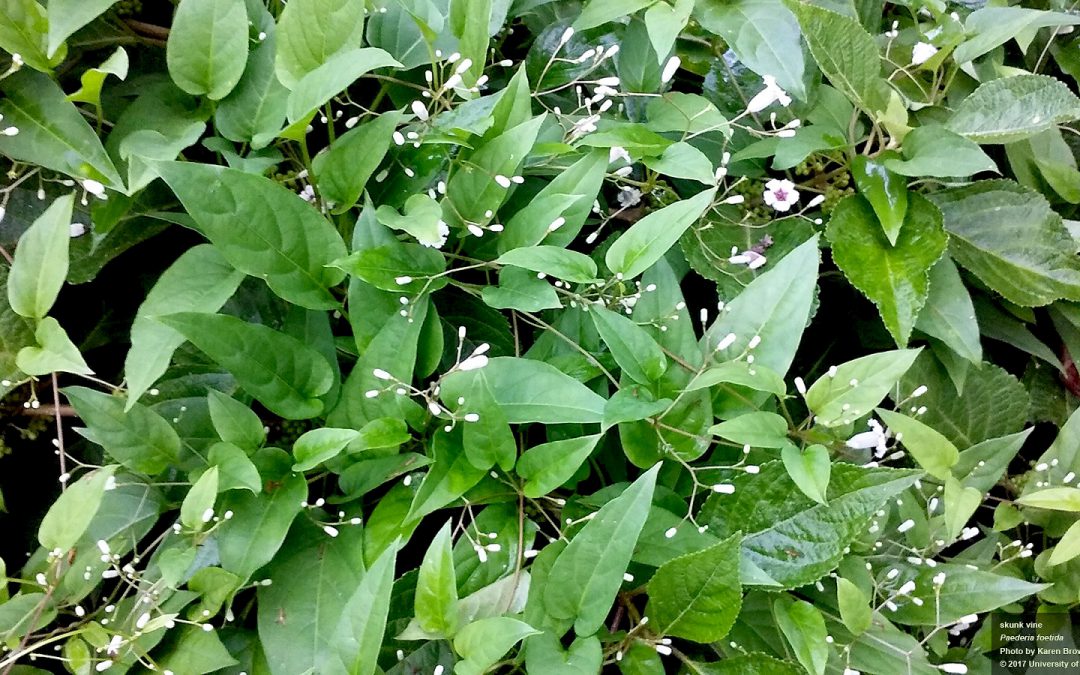
by Rick O'Connor | Mar 18, 2022
EDRR Invasive Species
Skunk Vine (Paederia foetida)

Skunk Vine
Photo: University of Florida
Define Invasive Species: must have ALL of the following –
- Is non-native to the area, in our case northwest Florida
- Introduced by humans, whether intentional or accidental
- Causing either an environmental or economic problem, possibly both
Define EDRR Species: Early Detection Rapid Response. These are species that are either –
- Not currently in the area, in our case the Six Rivers CISMA, but a potential threat
- In the area but in small numbers and could be eradicated
Native Range:
Eastern and southern Asia.
Introduction:
Around 1897 Skunk vine was introduced into Hernando County Florida as a possible fiber crop. It escaped cultivation and began to spread across central and north Florida.
EDDMapS currently list 1,252 records of skunk vine in the United States. Most are in central Florida but there are records in south and north Florida, as well as Louisiana, Texas, Georgia, South and North Carolina.
There 17 records in the Florida panhandle and 1 within the Six Rivers CISMA, that being in Santa Rosa County in the Blackwater State Forest.
Description:
This is a woody vine that can grow up to 30 feet. The vines are known to climb into the trees or grow along the ground. When crushed, the plant emits a foul odor, hence its name, and can be used to positively identify it. The leaves vary in shape but usually are heart shaped at the base, pointed at the tips, and have smooth margins. The flowers are small, light grayish pink in color, with red centers. The fruits are small and shiny brown. It can spread vegetatively or by seed.
Issues and Impacts:
This plant can survive in a variety of habitats including dense hardwood forest, pine forest, sandhills, floodplain forest, and marshes. Like kudzu and other vines, this plant will overgrow native plants on the ground and over trees. It can fill a tree canopy causing the collapse of it. It is a Category I invasive plant and a state noxious weed.
Management:
Care must be taken when trying to remove this plant. Stem fragments and seeds are easily lost when moving and can generate new plants. Extensive flooding may kill the plant, but it is known to live submerged for up to 190 days.
Skunk vine tends to invade open-disturbed areas within the forest. Mowing and tilling can help but are impractical in many cases. Studies on biological controlling insects are ongoing and show much promise.
Chemical control seems to be the most effective method at the moment, but single applications rarely complete the job. Triclopyr, with a surfactant, as a foliar spray has been effective. Glyphosate has also been effective. Care must be taken not to overspray onto other plants. Vines growing in trees should be pulled down and then sprayed to allow the herbicide to be pulled into the root system. The best time of year to do this is spring and summer.
Please report any sighting to www.EDDMapS.org. There are biologists who verify the photograph you send. It is important that we keep track of this EDRR species.
For more information on this EDRR species, contact your local extension office.
References
Paederia foetida. Skunk Vine. University of Florida Center for Aquatic and Invasive Plants. https://plants.ifas.ufl.edu/plant-directory/paederia-foetida/.
Early Detection and Distribution Mapping System (EDDMapS)
https://www.eddmaps.org/
Six Rivers CISMA
https://www.floridainvasives.org/sixrivers/
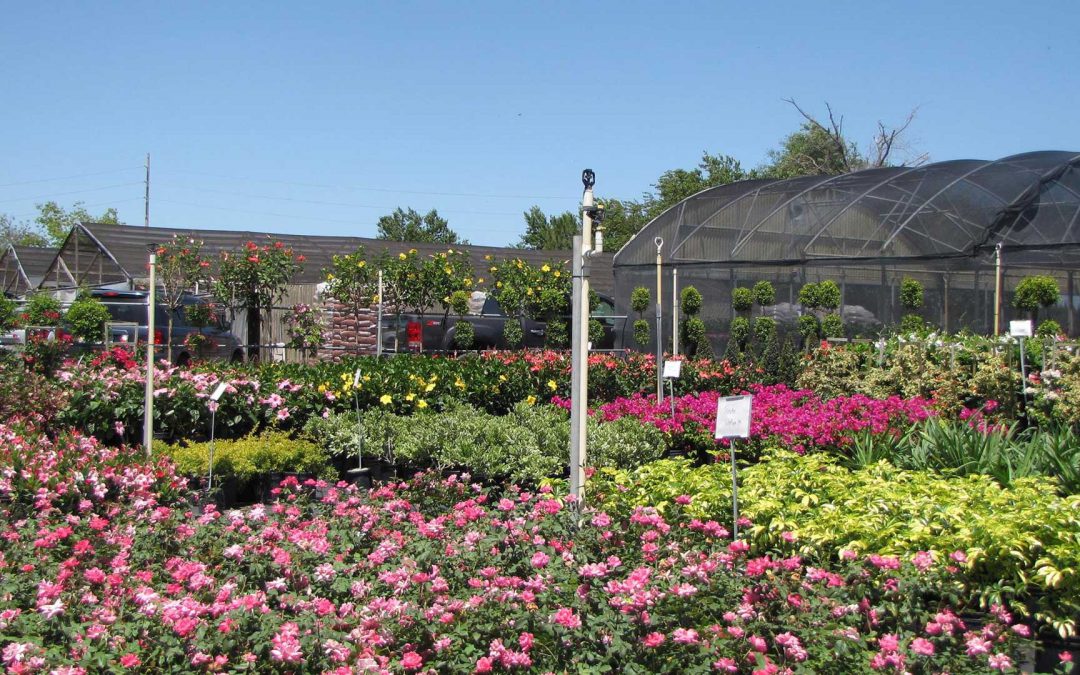
by Rick O'Connor | Mar 18, 2022
It is that time of year. The time of year when many head to their favorite nurseries to do their spring landscaping and gardening. Many of the plants sold at these locations are actually grown in more southern climates, where there are numerous invasive species of all sorts. Many of these invasive species have not made their way to the Florida panhandle but can hitchhiker on these plants when they are shipped up this way. Care should be taken when purchasing to make sure you are not bringing anything home other than the plant you want.
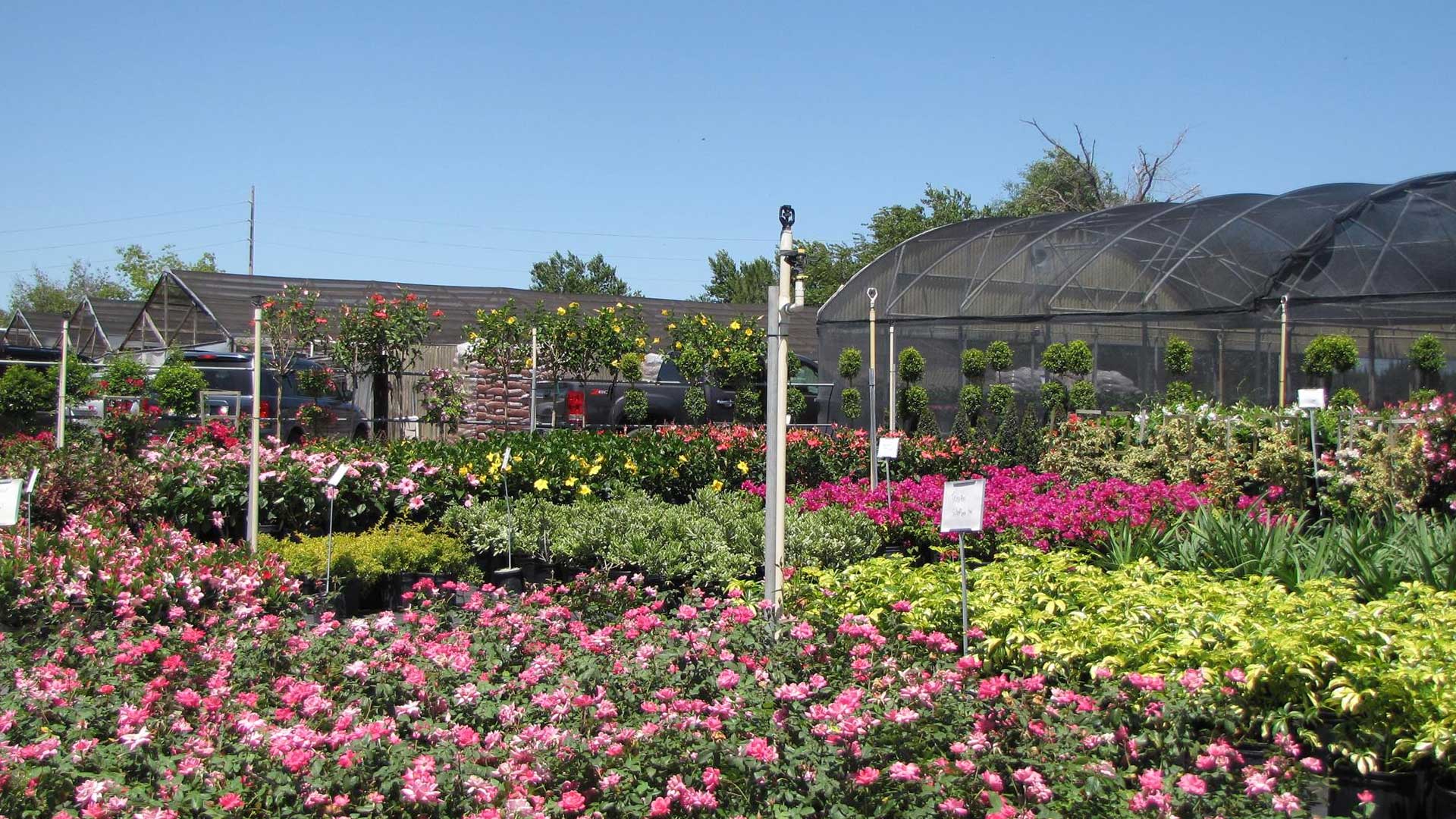
Nurseries provide native and nonnative plants.
The best management tool for invasive species is prevention. Across the country, particularly out west, there are survey stations at public lakes and reservoirs where state officials inspect boats and trailers when they arrive and when they leave the lake. There are hiking boot brushes at the entrance and exists to trails and active machine cleaning efforts after working in the field. Here in Florida, we do not pay as close attention to this. Machinery, boats, and plants are moved with little or no inspection. On any shipped plant could be an insect, slug, lizard, or frog that could eventually cause trouble for us. We are sure this is how the brown anole was introduced and we now getting reports of Cuban treefrogs in the panhandle.
Potential threats as EDRR species to our area include channeled apple snails, Cuban treefrogs, and greenhouse treefrog. With pond plants we need to be on the watch for several including Eurasian milfoil, water hyacinth, giant salvinia, and hydrilla. We also want to avoid purchasing and planting beach vitex, callery pear, coral ardisia, guinea grass, natalgrass, skunk vine, and swamp morning glory since they are all considered potential threats to the western panhandle.
If you have a question as whether a specific plant is invasive or not, you can visit the University of Florida’s Center for Aquatic and Invasive Plant website – https://plants.ifas.ufl.edu/.
The University of Florida IFAS Assessment website – https://assessment.ifas.ufl.edu/.
Or contact your county extension office.











